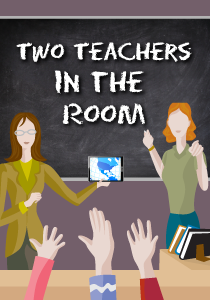Straddling the Co-Teaching Fence
A MiddleWeb Blog

I’ve invited Johnny, who has been both a co-teacher and a “general” teacher working with a co-teacher, to share some of his experience and insight as my first guest author! – Elizabeth Stein
by Johnny M. Cataffo
Co-teaching can be challenging, but it’s not without its rewards. Students’ academic gains aren’t the only improvements teachers may see in a co-teaching environment. Confidence, contentment, and risk-taking are all attributes that can soar when students are given a chance to experience success with their peers.
I speak not only as a special educator who taught in classrooms as a co-teacher for five years, but as someone who has “worked on both sides of the fence.” I am now a fourth grade general educator working in a co-taught classroom with a wonderful special education partner. My special education background has certainly given me perspective that some general teachers may lack when they first have a co-teacher in the room. And of course I’m gaining new insights as I see the relationship from a different vantage point.
Co-teaching challenges
One of the biggest challenges special educators face as we move into a General Education classroom from a self-contained environment is becoming accustomed to the expectation of time.
In the past, time was irrelevant to Special Education. Even after the move into a co-taught room, I held onto the belief that my Special Education students should be given more time to learn things. They were, after all, “slower” than the other students. Eventually, though, I began to realize that the amount of time they needed depended less on their disabilities and more on my expectations of what they could do. Like many other special educators, I had fallen into a pattern of giving my students accommodations upfront, because I was sure they needed them, rather than giving them the chance to show what they could do first. I began to change my outlook.
Seeing the situation from the general educator’s side of fence has reinforced my decision to change. More than ever, I can see how much it hurts students to “water down” their experiences. Rather than determining the level of support and accommodation ahead of time, we allow all of our students to try things on their own and bring in supports as needed.
We are finding that more often than not, the students rise to the challenge, relying on fewer tools and modifications. Even students whose disabilities are more severe have surprised us with what they can do. I’m not saying students should not be given accommodations, but that our practice of accommodating as a last resort has really shown us the true picture of what a child needs to reach and grow.
Every student is different
In General Education, I have found the “one-size-fits-all” syndrome is all too common. Many teachers, whether they realize it or not, fall into a pattern of uniform expectations. I’m not talking about the differences between general and special education students here, as much as the differences among general education students.
Special educators come to differentiation by nature and training. After 15 years in the Special Education world, I have witnessed overwhelming evidence that all students are unique and so are their educational needs. Every student, whichever side of the fence we place them, needs differentiated learning experiences to be successful.
Differentiating in the inclusion setting
So how do we offer different instruction in the inclusion classroom? We use another concept brought over from Special Education: station teaching/ability grouping. Many teachers already use this concept, but not effectively. They group students according to reading levels, and those groups stay the same through most of the year. True ability groups are fluid, changing based on periodic assessments and observations of each student’s growth and development.

Small groups are the perfect opportunity to fully utilize both the general and special education co-teacher. The small groups can be tailored based on the students who are struggling with a particular skill (not a general reading score, etc.). Neither teacher is “stuck” with the same kids each and every day. And the same is true for the kids. Students get the benefit of teacher variety while their needs are better met.
With the main focus on small-group teaching, flexibility expands significantly — group times and participants are fluid, adjusting to changes in schedules and the results of formative assessments.
These are some of the actions my co-teacher and I have taken since I’ve made the transition from Special Education to General Education teacher. I hope to cover these and other practices with more depth in future posts.
Meanwhile, if you happen to be a teacher who has taught on both sides of the co-teaching partnership, what are some of your own aha moments?




































What are the other children doing when you are teaching a small group? What happens if they misbehave or need you?
Thank you for sharing Mr. Cataffo. I enjoyed reading your thoughts on raising the expectations for students, every student is different and the use of differentiated instruction and I will be sharing this with other educators, professionals, parents AND students.
That’s a great question Ritu. One of the things I love most about station teaching is it tends to reduce behavior problems by design. Putting students into smaller groups increases attention and allows you to really differentiate the activities for each group. My preferred method is to ability group at least part of the time to allow students to work on activities I know they can perform independently. For students who really struggle, I include computer activities designed to improve skills. At times, there can be a lot going on at once, but the end result is worth it. To encourage good behavior, I give the students the power to reward their peers. A success log is kept at the front of the room and I encourage students to reward those who are showing outstanding citizenship and cooperation skills. Students aren’t always 100% engaged, but I have found far better engagement—not to mention better test scores—with these techniques than with whole class teaching.
Thanks Jen! I appreciate the feedback!
What about gifted and advanced students and the legal liability of NOT making the accommodations for special needs students?
There is a difference between differentiation for gifted and advanced learners and making accommodations for special needs learners. It’s a big challenge for teachers to do all of it, especially when there is rarely a co-teacher with gifted experience who can help prepare the necessary resources and activities to extend or accelerate learning for these students.
Great question, Susan Rakow. Actually, as it turns out I also teach Gifted and Talented students in addition to my co-taught class. While they are two separate classes, I have to take into accounts both groups of students when planning lessons. Also, I have a handful of students in my co-taught class who benefit from some of the same activities as my Gifted and Talented students (a couple I suspect are close to being G/T themselves). So how do you keep the level of rigor needed for those high-functioning students while still meeting the needs of your students with special needs? Here’s where station teaching again provides the perfect opportunity to meet individual needs. I spend no more than 10-15 minutes on my lessons each day. I actually set a timer to ensure I don’t go over that amount of time. It may sound odd, but I’ve found that the majority of my students get less than 20% of what I’ve shown them full-class.
Once my students are broken into stations, I reteach the lesson to those I know need it the most. The rest rely on peers to help them if they get stuck (we spend time at the beginning of the year modeling what helping looks like and ensure students aren’t just giving answers. Periodic sweeps through the classroom can also keep stragglers on task). I allow students to reward each other for good behavior and hard work. My G/T students always tend to finish early. While in stations, they can assist others, but I also encourage them to finish early so they can move on to the “challenge” activities. I’ve noticed this reinforces the skills they know, allows them to teach others what they know, then provides them an extension to move them into those higher-levels of Bloom’s. It’s a win-win for all the students. Once those students move into the “challenge” activities, they are on their own and must work together to solve more complex problems. This builds independence and allows for collaborative thinking. In a nutshell, it’s all about accommodating the lesson in both directions. Simplifying some things for your SPED and strugglers, while enhancing others for your higher-performers. The students all know we each have our unique talents and challenges and understand when they may not all be working on the same things. If a student wants to try a challenge activity, they must first complete their assigned work and then I always let them try. Sometimes they’ll surprise you. I hope this helps!
Can you recommend instructional materials for a new Special ed Inclusion teacher that has not used the co-teaching method?
“One of the biggest challenges special educators face as we move into a General Education classroom from a self-contained environment is becoming accustomed to the expectation of time.”
It concerns me that there are special educators thinking this way. In my experience, SPED has never been about giving students unlimited time. It is about teaching students to be independent in a way that is most effective for them. Giving unlimited time for difficult tasks prevents students from growing in their abilities and pushing themselves to reach achievable goals.
I understand the concept of ability grouping and agree that it can be beneficial if there is a teacher/EA at the group to provide intervention as necessary. However, I prefer to balance ability levels and encourage students to work with all abilities similar to what they will experience in the real world.